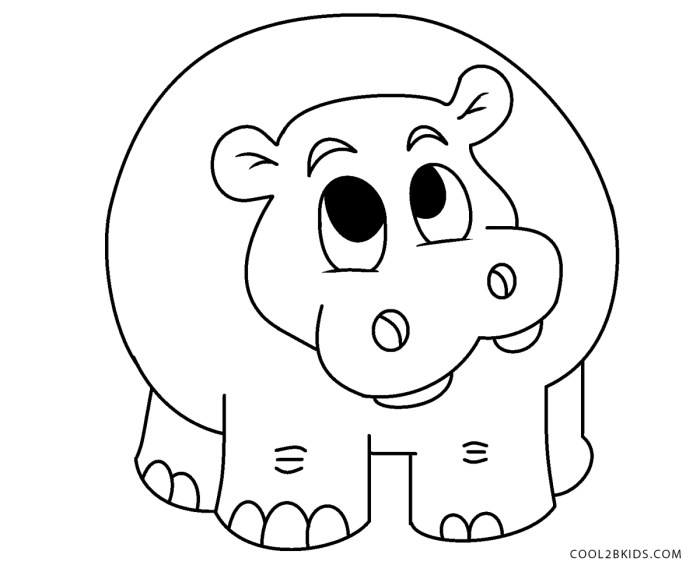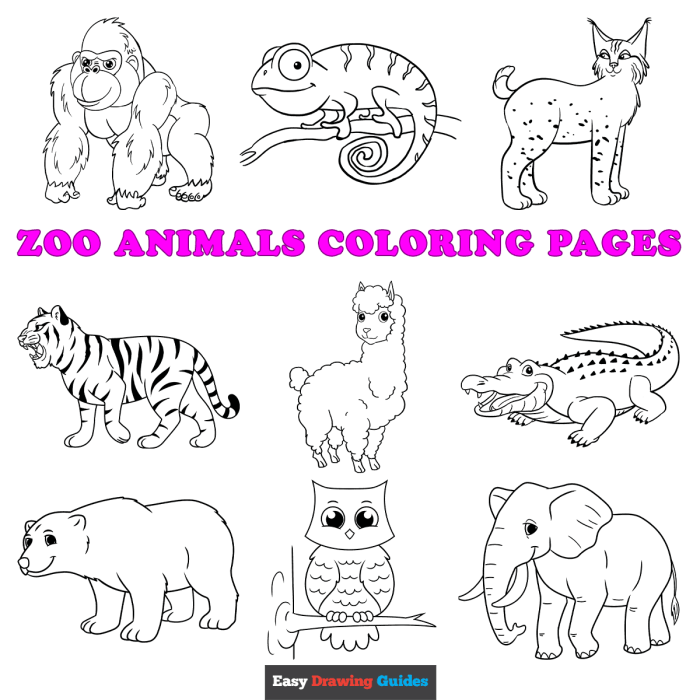Design Elements of Effective Zoo Animal Coloring Pages

Alright, buckle up, buttercup! Designing a killer zoo animal coloring page isn’t just about slapping some lines on paper. It’s about unleashing a child’s inner Picasso (or maybe their inner Banksy, who knows?). We’re talking serious artistic firepower here.
To create a truly captivating coloring page, you need to think like a kid – a very imaginative, slightly messy kid. What grabs their attention? What makes them want to grab those crayons and go wild? Let’s dive into the nitty-gritty.
Visually Appealing Characteristics of Zoo Animal Coloring Pages
Think big, bold, and beautiful! We’re not talking delicate watercolors here (unless you’re aiming for a specific artistic style, of course). Kids love clear, simple lines that are easy to follow. The animals should be recognizable, even if they’re slightly stylized. Think expressive eyes, charming poses, and maybe a playful element like a bubble or a butterfly flitting nearby.
Avoid overly complex details that might frustrate little artists. Remember, the goal is fun, not frustration!
Color Palettes and Shading Techniques
Color is king! A limited, vibrant palette is usually best for younger children. Think primary colors with maybe a few secondary shades thrown in for good measure. For older kids, you can introduce more sophisticated palettes, even exploring complementary or analogous color schemes. As for shading, simple techniques like cross-hatching or stippling are great for adding depth and dimension without overwhelming the design.
Think of it as adding a touch of magic, not a math lesson.
Examples of Different Line Art Styles, Zoo animal coloring page
The line art style can make or break your coloring page. Let’s explore some fun options:
- Cartoon Style: Think big, round eyes, exaggerated features, and playful poses. This style is perfect for younger children.
- Realistic Style: This approach focuses on accurate anatomical details, suitable for older children who enjoy a challenge.
- Geometric Style: Using simple shapes to create the animal, this style is both modern and engaging.
- Doodle Style: A more free-flowing, less structured style, perfect for encouraging creativity and self-expression.
Sample Coloring Page: The Playful Panda
Let’s design a coloring page featuring a panda! We’ll use a cartoon style for its wide appeal. The panda will be sitting upright, munching on bamboo, with a slightly mischievous glint in its eye. The line art will be bold and black, with simple, easily colored sections. The background will be left blank to allow for creative freedom.
We’ll use a limited palette of black, white, and shades of grey for the panda, allowing children to focus on the animal itself. A few simple, scattered bamboo leaves around the panda will add a touch of detail without being overly complex. The overall feel will be playful and inviting, encouraging children to unleash their creativity and have fun.
Educational Value and Applications of Zoo Animal Coloring Pages

Let’s face it, coloring pages aren’t just for kids anymore! They’re a surprisingly powerful tool for learning and development, especially when they feature the captivating world of zoo animals. Think of it as a sneaky way to make education fun – and who doesn’t love that?Coloring pages contribute significantly to a child’s cognitive development in several ways. It’s not just about filling in spaces with color; it’s a complex process involving fine motor skills, hand-eye coordination, and even creativity and self-expression.
Imagine a little Picasso carefully shading a lion’s mane, or a budding artist meticulously detailing a zebra’s stripes – it’s a masterpiece in the making! Beyond that, the act of choosing colors and creating a visual representation fosters imagination and problem-solving skills.
Incorporating Educational Elements into Zoo Animal Coloring Pages
Adding educational elements to zoo animal coloring pages elevates them from simple playtime activities to valuable learning tools. Think of it as a fun quiz disguised as art! By including facts about the animals – their habitats, diets, or unique behaviors – children can learn while they color. For example, a coloring page of a polar bear could include a small fact box mentioning its love for icy waters and fish.
This approach transforms a passive activity into an active engagement with learning.
Examples of Zoo Animal Coloring Pages in Educational Settings
Let’s dive into some practical examples of how these coloring pages can be used in educational settings. The following table showcases diverse activities catering to various age groups, emphasizing the educational benefits and necessary materials.
Yo, check it, zoo animal coloring pages are kinda lit, right? But if you’re feeling something a little more, like, down-to-earth, you know, check out these farm animal coloring pages for a chill vibe. Then, after you’ve colored those cows and pigs, get back to those fierce tigers and majestic lions in your zoo pages!
| Activity | Age Group | Educational Benefit | Materials Needed |
|---|---|---|---|
| Coloring page with animal fact labels | 3-5 years | Develops color recognition, fine motor skills, and introduces basic animal facts. | Zoo animal coloring pages, crayons, fact labels |
| Create a zoo habitat diorama after coloring | 5-7 years | Improves spatial reasoning, encourages creativity, and reinforces learning about animal habitats. | Zoo animal coloring pages, crayons, construction paper, scissors, glue, small toys (optional) |
| Research and color endangered animals, writing a short report | 8-10 years | Enhances research skills, improves writing abilities, and raises awareness about conservation. | Zoo animal coloring pages focusing on endangered species, crayons, pencils, paper, internet access |
| Design a zoo brochure featuring colored animals and facts | 10-12 years | Develops design and layout skills, strengthens writing and research skills, and fosters communication skills. | Zoo animal coloring pages, crayons, markers, computer/printer (optional), design software (optional) |
Integrating Zoo Animal Coloring Pages into Broader Learning Activities
Zoo animal coloring pages aren’t confined to standalone activities. They can seamlessly integrate into broader learning projects. For instance, after a classroom lesson on animal habitats, children could color animals specific to those habitats, creating a visual representation of what they learned. Or, after reading a story about a particular animal, they could color that animal and then write a short story of their own about its adventures.
The possibilities are as wild as the animals themselves!
Marketing and Distribution Strategies for Zoo Animal Coloring Pages

So, you’ve got a menagerie of magnificent zoo animal coloring pages ready to unleash upon the world. But how do you get them into the paws (or pencils) of eager young artists? Let’s dive into the wild world of marketing and distribution!
Target Audiences and Preferences
Our target audience isn’t just kids; it’s a whole ecosystem! We’ve got the little lion cubs (ages 3-6) who love bold colors and simple designs. Then there are the teenage gorillas (ages 13-17) who might prefer more intricate illustrations and maybe even a touch of realism. And don’t forget the adult orangutans (adults), who appreciate detailed artwork for stress relief or even artistic inspiration.
Each group has different preferences, so we need a marketing strategy that roars with appeal to all! For example, the younger crowd will respond to bright, cartoonish animals, while older audiences might appreciate more photorealistic renderings or even coloring pages with added elements like mandalas or patterns.
Marketing Plan for a New Line of Zoo Animal Coloring Pages
Let’s say we’re launching “Zoo Crew Coloring Craze!” We’ll price our single-page downloads at $1, packs of five at $4, and a complete collection at $15. Promotional strategies? We’re talking social media blitzkrieg! Think adorable animal videos on TikTok, eye-catching posts on Instagram, and engaging contests on Facebook. Collaborations with zoological societies and children’s bloggers could also generate a lot of buzz.
Imagine a contest where kids submit their colored pages for a chance to win a family trip to the zoo! We’ll also offer special discounts for early bird purchases and bundle deals to encourage bulk buys. And, of course, we’ll leverage email marketing to nurture leads and keep our customers engaged.
Online Marketplaces and Visually Appealing Product Listings
Etsy, Amazon Handmade, and even our own website – these are our digital watering holes. To attract customers, our product listings need to be as captivating as a pride of lions. High-quality images are crucial. Think vibrant, close-up shots of the coloring pages showcasing the detail and vibrancy of the artwork. We need clear, concise titles like “Majestic Lion Coloring Page – Detailed Adult Coloring Book” or “Cute Panda Coloring Page for Kids – Easy Fun Coloring Book.” Detailed descriptions should highlight the features: “High-resolution printable PDF, perfect for kids and adults, featuring a realistic illustration of a majestic lion.” Customer reviews will also be essential, showcasing positive feedback and building trust.
Consider adding a few mock-ups showing the finished colored pages, maybe even one done in different styles (realistic, cartoonish, etc.) to show the versatility of the product. We could even offer different versions of the same animal – one simpler for younger kids, one more detailed for older ones.
Print-on-Demand Services
Let’s not forget the tangible aspect! Print-on-demand services like Printful or Printify are our trusty allies. They handle printing and shipping, allowing us to focus on marketing and design. This reduces upfront costs and minimizes the risk of being stuck with unsold inventory. We can offer physical copies of our coloring pages through our website and online marketplaces, expanding our reach to customers who prefer a physical product.
The key here is to choose a provider that offers high-quality printing and reasonable shipping costs.
Other Distribution Methods
We can also explore partnerships with local bookstores, craft stores, and even zoos themselves! Imagine our coloring pages displayed alongside souvenirs in a gift shop. Direct sales at craft fairs and events are another avenue to consider. It’s all about diversifying our distribution channels to maximize reach and sales.
General Inquiries
Where can I find free zoo animal coloring pages?
Many websites offer free printable zoo animal coloring pages. A quick online search should reveal numerous options!
Are zoo animal coloring pages suitable for toddlers?
Yes, simpler designs with bold Artikels are perfect for toddlers. Supervise young children to prevent choking hazards from small parts.
What kind of paper is best for coloring zoo animal pages?
Heavier weight paper (like cardstock) is ideal to prevent bleed-through, especially with markers or watercolors. Regular printer paper works well with crayons and colored pencils.
Can I sell my own zoo animal coloring pages?
Yes, you can! However, be sure to check for copyright issues if you are using reference images. Consider using platforms like Etsy or creating your own website to sell your creations.
